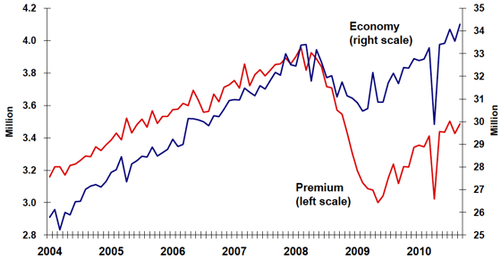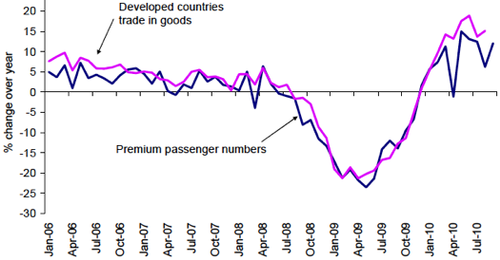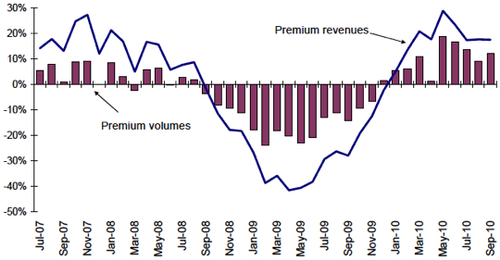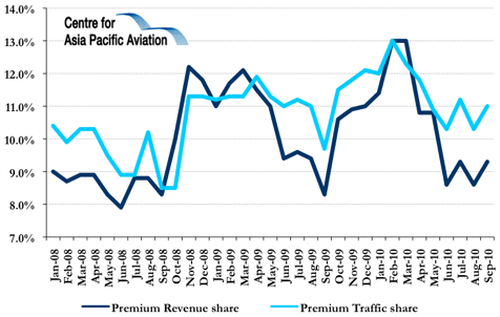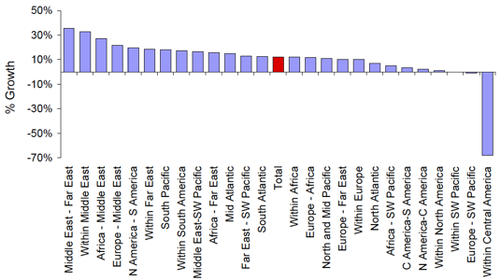Premium traffic recovery to continue in 4Q but remains below pre-crisis level: IATA
Premium traffic rebounded further in Sep-2010, increasing 12.1% year-on-year, although they still remain below pre-recession levels, according to the International Air Transport Association (IATA). IATA added that it expects the recovery in premium traffic to continue into the final quarter of the year.
IATA international air passengers (seasonally adjusted) by seat class: 2004 to Sep-2010
Despite the rebound, the Sep-2010 premium traffic levels remain some 11% below the figure for Sep-2007 and 4% lower than Sep-2008 although IATA added that the latest figures suggest that "earlier concerns over a stalling of recovery of premium traffic might have been misplaced". IATA continued: "Business travel continues to be the key to overall international travel markets, with business confidence moving higher in major economies but consumer confidence weakening."
Premium traffic grew strongly in 3Q2010, up 10.3% year-on-year, although levels remain some 5% below 3Q2008 levels and just over 8% below 3Q2007 levels. IATA also stated that the latest trade data and output from the business confidence surveys suggest continuing underlying momentum for premium traffic.
Premium passengers and world trade growth: Jan-2006 to Sep-2010
Economy traffic, meanwhile, has recovered "relatively rapidly" from the downturn and, on a seasonally adjusted basis, is above 2007 levels. Economy traffic increased 9.3% in Sep-2010 to be 9.4% above Sep-2008 levels with growth of 6% from Sep-2007 levels. However, IATA cautioned that the latest consumer confidence data shows another downward tick in the index but added that it is "too early to determine whether this is the start of a trend or just a 'blip'".
Economy passengers and business and consumer confidence indexes: 2006 to Sep-2010
Pax levels up 9.5% in Sep-2010
The total number of passengers, measured by flight segment rather than true origin and destination grew by 9.5% year-on-year in Sep-2010, with passenger numbers up by around 6.4% on a year-to-date basis.
IATA added that the final figures for Aug-2010 suggested that the slowdown in that month was greater than first indicated with an increase in premium passenger numbers of 6.2% and of 4.9% for those travelling in the economy cabin. These rates were against a background where premium passengers in Jul-2010 had increased by 12.5% and economy by 7.8%.
Rate of premium revenue growth stabilising
Meanwhile, IATA commented that the rate of growth in premium revenues appears to have stabilised over the past three months. While yields are continuing to increase, IATA noted that volume effect on revenues has been greater in the third quarter than earlier in the year. In Sep-2010, premium revenue increased by 17% with volumes 12% higher. Comparatively, in May-2010 premium revenues were almost 29% higher on volumes up 19%.
Premium ticket volume and revenue growth: Jul-2007 to Sep-2010
Wide variations by region
There continues to be a range in experience between regions with the highest rates of premium traffic growth on routes that are within or to/from Asia.
IATA premium analysis by region: Sep-2010
|
Region |
Passenger growth |
|---|---|
|
North Atlantic |
Remains the single most important route area for premium traffic. Although economy traffic volumes are now above the corresponding months in 2008, premium traffic is up 7% and is showing a higher growth rate than both economy (up 5.2%) and the market overall (5.4%). Premium traffic volumes in Sep-2010 were still some 4% below those of Sep-2008. The weak outlook in Europe, at least in the near term will continue to determine overall volumes in this market. |
|
Intra-Europe |
Appears to show a dramatic decline in the monthly rate of change as well as the year-to-date growth from previous reports, reflecting a re-allocation of traffic on a more appropriate basis. IATA added that an element of domestic travel had been allocated to the international market. Although premium traffic has grown by some 10% in this region in Sep-2010, the structural change that was already evident before the recession in this market has continued. Premium traffic in Sep-2010 is still some 20% lower than that in Sep-2008 and closer to 28% below the level Sep-2007. |
|
The strongest rates of growth have been in Asia and on routes that involve travel to or from Asia. The main Asian routes (Within Far East, North and mid-Pacific, and Europe to Far East) which account for a third of premium revenues and just over 25% of premium traffic, have experienced growth rates between 10% and 18% for the month and are showing growth of between 12% and 23% for the year to date. |
|
|
Remains affected by the bankruptcy of Mexicana. |
|
|
The strength of premium traffic growth on the Europe to Middle East and Middle East to Far East routes is of "particular note". IATA stated the strength, in part, reflects the end of Ramadan but is also representative of the underlying strength of transfer traffic in the Gulf. Taken together these account for some 7.6% of total premium traffic and just over 7% of premium revenue. Growth in Sep-2010 on Europe- Middle East routes was 21.6% and on the Middle East-Far East routes was 35.6%; the year to date figures were 10.2% and 21.4% respectively. |
Premium traffic in the Within Far East region increased 18.5% in Sep-2010 and is 7% above Sep-2008 levels. For 3Q2010, premium traffic in the region increased by almost 19%.
IATA Middle East premium revenue share vs premium traffic share Jan-08 to Sep-2010
IATA international premium traffic growth by route: Sep-2010
Traffic and profits to slow in 2011
Although the key leading indicators remain broadly positive, growth rates from now will appear slower, due partly to the more "testing comparators" as traffic levels began to rise in the early stages of recovery during 2009.
The aviation industry is now reverting to slower growth with this trend consistent with IATA's recently revised global industry outlook which forecasts an industry profit of USD8.9 billion (up from the Jun-2010 forecast of USD2.5 billion) based on an exceptionally strong first half of the year.
However, the industry remains financially fragile, with ticket prices and yields still remaining depressed due to strong global competition despite recent improvements.
